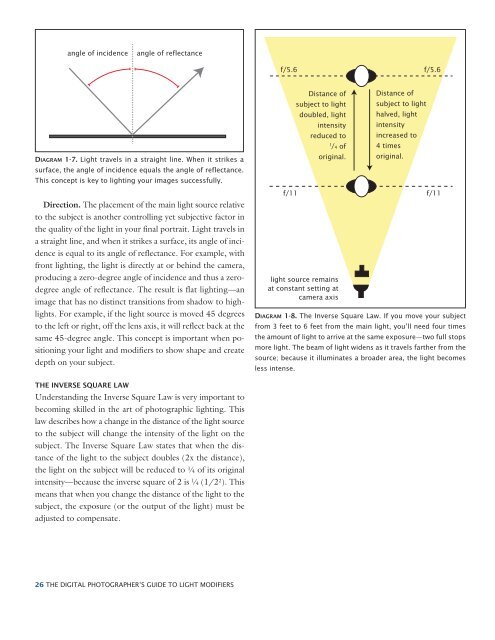Light Modifiers
You also want an ePaper? Increase the reach of your titles
YUMPU automatically turns print PDFs into web optimized ePapers that Google loves.
angle of incidence angle of reflectance<br />
DIAGRAM 1-7. <strong>Light</strong> travels in a straight line. When it strikes a<br />
surface, the angle of incidence equals the angle of reflectance.<br />
This concept is key to lighting your images successfully.<br />
Direction. The placement of the main light source relative<br />
to the subject is another controlling yet subjective factor in<br />
the quality of the light in your final portrait. <strong>Light</strong> travels in<br />
a straight line, and when it strikes a surface, its angle of incidence<br />
is equal to its angle of reflectance. For example, with<br />
front lighting, the light is directly at or behind the camera,<br />
producing a zero-degree angle of incidence and thus a zerodegree<br />
angle of reflectance. The result is flat lighting—an<br />
image that has no distinct transitions from shadow to highlights.<br />
For example, if the light source is moved 45 degrees<br />
to the left or right, off the lens axis, it will reflect back at the<br />
same 45-degree angle. This concept is important when positioning<br />
your light and modifiers to show shape and create<br />
depth on your subject.<br />
THE INVERSE SQUARE LAW<br />
Understanding the Inverse Square Law is very important to<br />
becoming skilled in the art of photographic lighting. This<br />
law describes how a change in the distance of the light source<br />
to the subject will change the intensity of the light on the<br />
subject. The Inverse Square Law states that when the distance<br />
of the light to the subject doubles (2x the distance),<br />
the light on the subject will be reduced to 1/ 4 of its original<br />
intensity—because the inverse square of 2 is 1/ 4 (1/22 ). This<br />
means that when you change the distance of the light to the<br />
subject, the exposure (or the output of the light) must be<br />
adjusted to compensate.<br />
26 THE DIGITAL PHOTOGRAPHER’S GUIDE TO LIGHT MODIFIERS<br />
f/5.6 f/5.6<br />
Distance of<br />
subject to light<br />
doubled, light<br />
intensity<br />
reduced to<br />
1 /4 of<br />
original.<br />
light source remains<br />
at constant setting at<br />
camera axis<br />
Distance of<br />
subject to light<br />
halved, light<br />
intensity<br />
increased to<br />
4 times<br />
original.<br />
f/11 f/11<br />
DIAGRAM 1-8. The Inverse Square Law. If you move your subject<br />
from 3 feet to 6 feet from the main light, you’ll need four times<br />
the amount of light to arrive at the same exposure—two full stops<br />
more light. The beam of light widens as it travels farther from the<br />
source; because it illuminates a broader area, the light becomes<br />
less intense.



